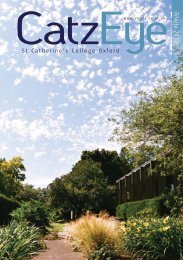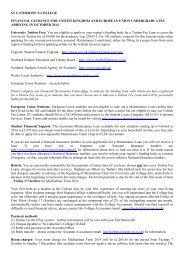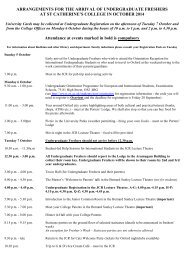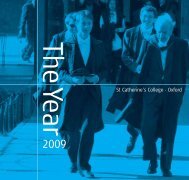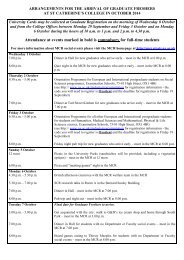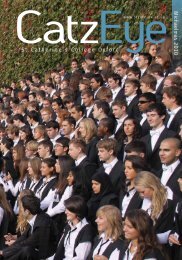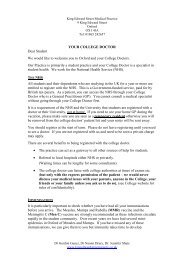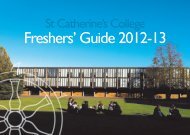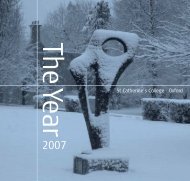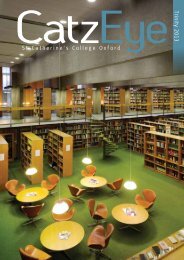Download PDF - St. Catherine's College
Download PDF - St. Catherine's College
Download PDF - St. Catherine's College
- No tags were found...
Create successful ePaper yourself
Turn your PDF publications into a flip-book with our unique Google optimized e-Paper software.
CATZ FELLOWSAndrew BunkerTutor in Physics, Reader in AstrophysicsOur ownhorizon ina possiblyinfiniteuniverseis 14 billionlight yearsaway ...Andrew Bunker has recently joined <strong>St</strong> Catherine’s<strong>College</strong> as a Fellow in Physics, and is also a Reader inthe Astrophysics Department. He has been a researchastronomer for fifteen years, and moves to Oxford fromAustralia, where he was Head of Astronomy at theAnglo-Australian Observatory.What, in layman’s terms, do you research?My research involves using some of the most powerfultelescopes in the world – in Australia, Hawaii and Chile– to find distant galaxies and study their evolution.<strong>St</strong>udying objects far away means that we are seeingthe light when it left them, billions of years ago.Essentially we are using telescopes as time machines,to see what galaxies were like when the Universe wasyoung. Our own horizon in a possibly infinite universeis 14 billion light years away, and we know that galaxiesexist as early on as 95% of the way back in time to theBig Bang. My research also involves using data collectedby the Hubble Space Telescope to take pictures ofthese distant galaxies, seen during the first billionyears of history.Is your involvement with the Hubble SpaceTelescope long-standing?I have been involved with Hubble since the mid-1990s,when I was a post-doctoral researcher at the Universityof California, Berkeley, and worked with the instrumentteam for NICMOS, a camera that sees in the infra-red(longer wavelengths than visible light). I am nowinvolved with Hubble’s successor – the James WebbSpace Telescope. As with Hubble, the project is a jointUS and European one; the European side is constructingan important instrument, known as a spectrograph.By reading the different types of light that are emittedfrom distant galaxies the spectrograph will enable usto look for the fingerprints of the different elementsthat constitute them. We will also be able to use thespectrograph to measure the speed of stars which –because the more massive the galaxy, the faster thestars travel – will allow us to weigh galaxies.What drew you to astronomy?I have always been fascinated by the night sky. As achild I read popular science books and was intrigued by46/ANDREW BUNKER



